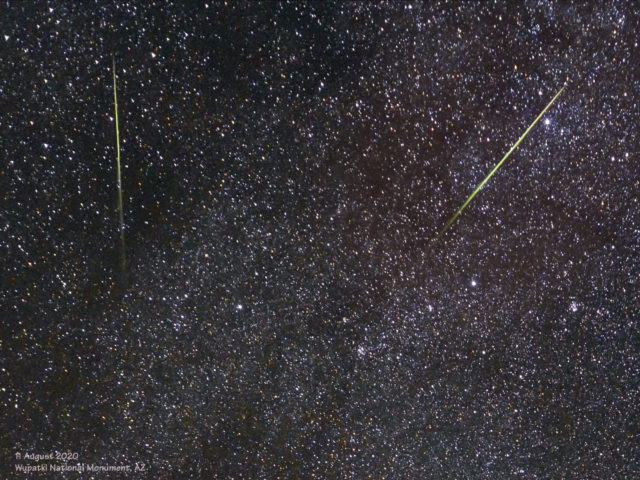The Perseids meteor shower is an always popular sky event. Perhaps one reason is that it occurs during the warm summer months and can be a pleasant family event.

We found ourselves at a parking lot in Wupatki National Monument—an International Dark Sky Park. Two other groups of two were also there but the parking area is big and maintaining distance was easy.
Photographing a meteor shower is always about trade offs. If you shoot with an ultra-wide lens the meteors are small and you will likely miss some of the dimmer ones. But the wide angle view ensures that you cover a large portion of the sky.
Another option is to shoot with a lens that is in the “normal” range or even a telephoto. The disadvantage is the field of view is greatly reduced while an important advantage is that the lens will capture the dimmer meteors.
The Lens Aperture Area versus Angular Coverage Trade
Because meteors appear in random location across the entire night sky, one might think that an all sky camera would pick up the most meteors. But this is not the case. Wide angle lenses mean short focal lengths and short focal lengths have smaller physical lens apertures, so collect less light. Thus, there is a trade between lens technology to collect a lot of light and angular coverage…Another factor in meteor capture is where to point. If one points closer to the radiant then the angular velocity of a meteor decreases and the longer focal lengths are not impacted as much.
For several years I shot with wide-angle and ultra-wide-angle lens (28mm, 24mm, and 16mm). More recently, I been shooting with 50mm and 85mm lens. Last year, with the 85mm lens I captured one (1) meteor. But the detail was great!
This year I shot with a 50mm lens. This is an old, legacy lens: Nikon 50mm ƒ/1.8 AI manual focus.
We set up the camera on a star tracker, dialed in the settings, and then let it go taking continuous shots at ƒ/2.8, 30 seconds, and ISO 1600. The camera was pointed with the radiant in the lower left corner. Also visible in the composite is Andromeda Galaxy (M31) in the upper right. Meanwhile, we pulled out the camp chairs and leaned back to stare at the sky for a few hours.
We saw a few dozen meteors in about 2-1/2 hours and the camera with its smaller FOV captured considerably fewer. As the Moon rose above the horizon we packed it all away and drove home. Reliable reports indicate that meteor activity picked up considerably in the pre-dawn hours. We were happily asleep at that time.

The first image is a stack of the handful of shots containing meteors and downsized for this posting. The second image (full-size image), on the other hand, is a full-size crop of two meteors showing how much detail can be found when using a fast lens with a narrow field of view.